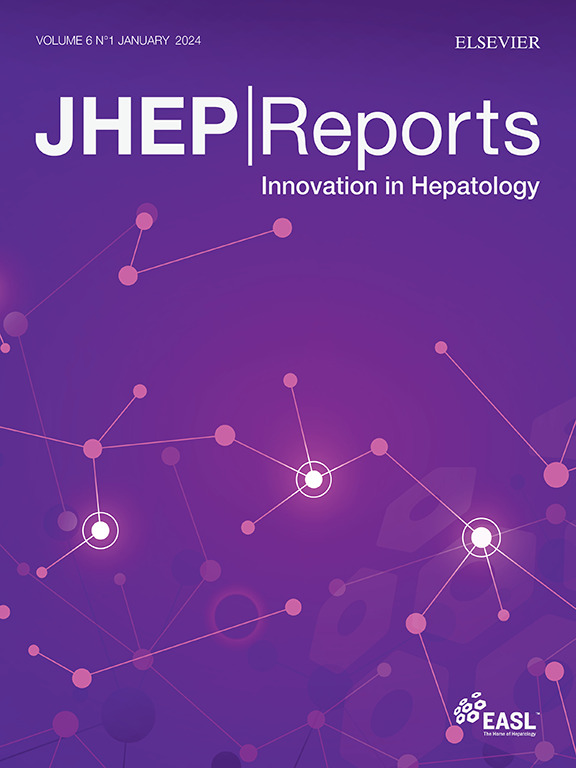Macrophage Notch1 signaling modulates regulatory T cells via the TGFB axis in early MASLD
IF 9.5
1区 医学
Q1 GASTROENTEROLOGY & HEPATOLOGY
引用次数: 0
Abstract
Background & Aims
Hepatic immune imbalance is crucial for driving metabolic dysfunction-associated steatotic liver disease (MASLD) progression. However, the role of hepatic regulatory T cells (Tregs) in MASLD initiation and the mechanisms responsible for their change are not completely understood.
Methods
A mouse model subjected to a short-term high-fat diet (HFD) to mimic early steatosis, along with liver biopsy samples from patients with simple steatosis, and macrophage-specific Notch1-knockout mice (Notch1M-KO), were used to investigate the role of Tregs in early MASLD and the effect of hepatic macrophage Notch1 signaling on Treg frequency. The miRNAs correlated with Treg differentiation were analyzed using exosomal miRNA sequencing.
Results
A decrease in Tregs contributed to HFD-induced hepatic steatosis and insulin resistance (five/group/time point, p <0.001). Remarkably, the frequency of Tregs was negatively correlated with Notch1 activation in hepatic macrophages during hepatic steatosis (38/group, r = -0.735, p <0.001). Furthermore, Notch1 deficiency attenuated hepatic lipid deposition and reversed Treg levels (five/group, p <0.01 and <0.05, respectively). Moreover, Treg depletion in Notch1M-KO mice greatly diminished the ameliorative effect of macrophagic Notch1 deletion on hepatic steatosis. Mechanistically, macrophage Notch1 activation increased the level of exosomal miR-142a-3p (by one- to two- fold), impairing Treg differentiation by targeting transforming growth factor beta receptor 1 (TGFBR1) on T cells. Consistently, HFD-fed Notch1M-KO mice exhibited reduced miR-142a-3p levels, elevated TGFBR1 expression on T cells, and increased Treg frequency in the liver.
Conclusions
These findings highlight the crucial role of hepatic Tregs during the early stage of MASLD and add a novel, non-negligible pathway for macrophage involvement in hepatic steatosis. We identify a previously unrecognized molecular mechanism involving the macrophage Notch1/exosomal miR-142a-3p/TGFBR1 pathway in regulating Treg differentiation, providing a rationale for refined therapeutic strategies for MASLD.
Impact and implications:
The immune mechanisms driving MASLD progression, particularly during the early stages of disease, are not fully understood, which limits the development of effective interventions. This study elucidated a novel mechanism by which hepatic macrophage Notch1 signaling modulated Tregs through the exosomal miR-142a-3p/TGFBR1 axis, contributing to the progression of MASLD. These findings provide a rationale for a potential immunological approach to treat MASLD in the future.

巨噬细胞Notch1信号在早期MASLD中通过TGFB轴调节调节性T细胞。
背景与目的:肝脏免疫失衡是驱动代谢功能障碍相关脂肪变性肝病(MASLD)进展的关键因素。然而,肝调节性T细胞(Tregs)在MASLD起始中的作用及其变化机制尚不完全清楚。方法:采用短期高脂饮食(HFD)模拟早期脂肪变性的小鼠模型,以及单纯性脂肪变性患者的肝活检样本和巨噬细胞特异性Notch1敲除小鼠(Notch1M-KO),研究Tregs在早期MASLD中的作用以及肝巨噬细胞Notch1信号通路对Treg频率的影响。使用外泌体miRNA测序分析与Treg分化相关的miRNA。结果:Tregs的减少有助于hfd诱导的肝脂肪变性和胰岛素抵抗(5 /组/时间点,p p p M-KO小鼠),大大降低了巨噬细胞Notch1缺失对肝脂肪变性的改善作用。从机制上讲,巨噬细胞Notch1激活增加了外泌体miR-142a-3p的水平(1至2倍),通过靶向T细胞上的转化生长因子β受体1 (TGFBR1)来损害Treg分化。同样,hfd喂养的Notch1M-KO小鼠表现出miR-142a-3p水平降低,T细胞上TGFBR1表达升高,肝脏中Treg频率增加。结论:这些发现强调了肝脏Tregs在MASLD早期的关键作用,并为巨噬细胞参与肝脂肪变性增加了一种新的、不可忽视的途径。我们发现了一个以前未被认识的巨噬细胞Notch1/外泌体miR-142a-3p/TGFBR1通路调节Treg分化的分子机制,为改进MASLD的治疗策略提供了理论依据。影响和影响:推动MASLD进展的免疫机制,特别是在疾病早期阶段,尚未完全了解,这限制了有效干预措施的发展。本研究阐明了肝巨噬细胞Notch1信号通过外泌体miR-142a-3p/TGFBR1轴调控Tregs,促进MASLD进展的新机制。这些发现为未来潜在的免疫治疗MASLD提供了理论依据。
本文章由计算机程序翻译,如有差异,请以英文原文为准。
求助全文
约1分钟内获得全文
求助全文
来源期刊

JHEP Reports
GASTROENTEROLOGY & HEPATOLOGY-
CiteScore
12.40
自引率
2.40%
发文量
161
审稿时长
36 days
期刊介绍:
JHEP Reports is an open access journal that is affiliated with the European Association for the Study of the Liver (EASL). It serves as a companion journal to the highly respected Journal of Hepatology.
The primary objective of JHEP Reports is to publish original papers and reviews that contribute to the advancement of knowledge in the field of liver diseases. The journal covers a wide range of topics, including basic, translational, and clinical research. It also focuses on global issues in hepatology, with particular emphasis on areas such as clinical trials, novel diagnostics, precision medicine and therapeutics, cancer research, cellular and molecular studies, artificial intelligence, microbiome research, epidemiology, and cutting-edge technologies.
In summary, JHEP Reports is dedicated to promoting scientific discoveries and innovations in liver diseases through the publication of high-quality research papers and reviews covering various aspects of hepatology.
 求助内容:
求助内容: 应助结果提醒方式:
应助结果提醒方式:


